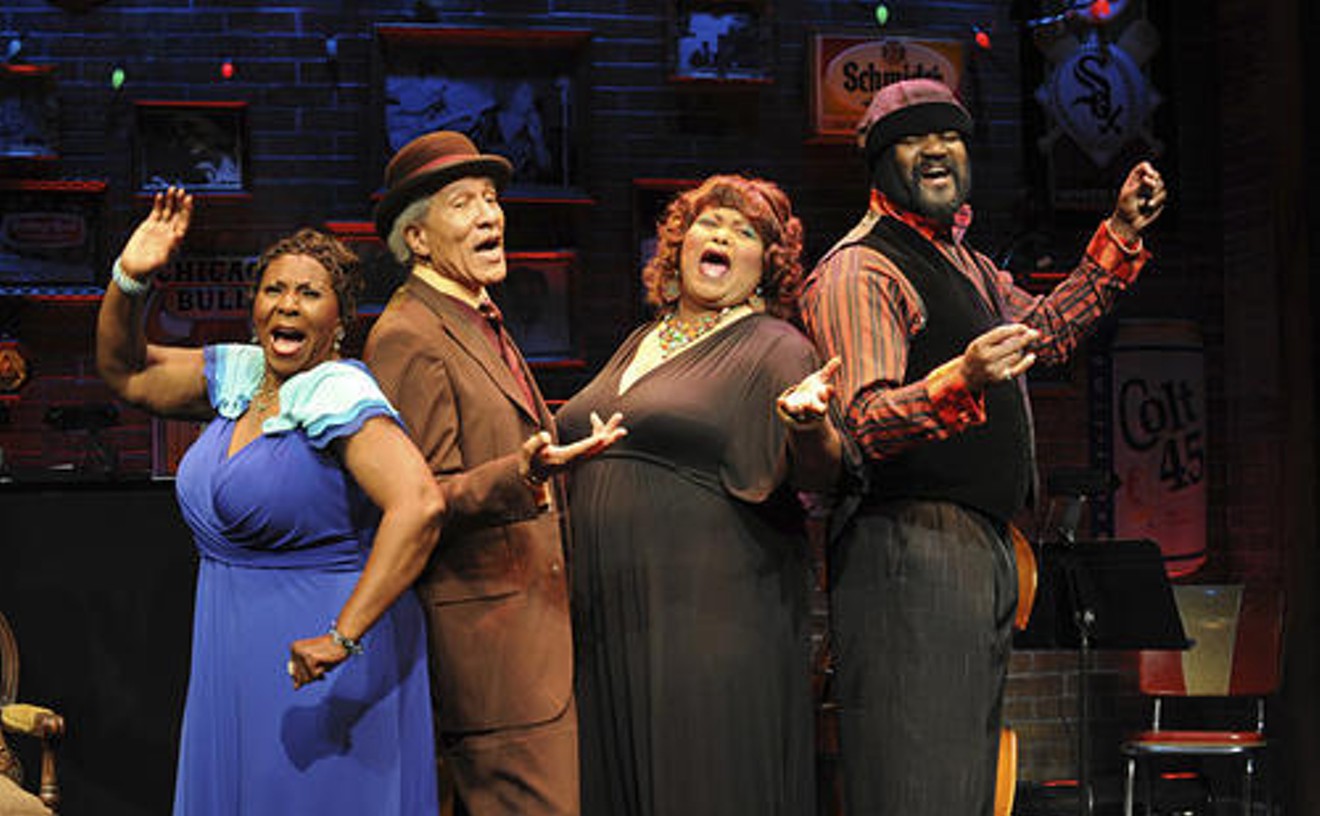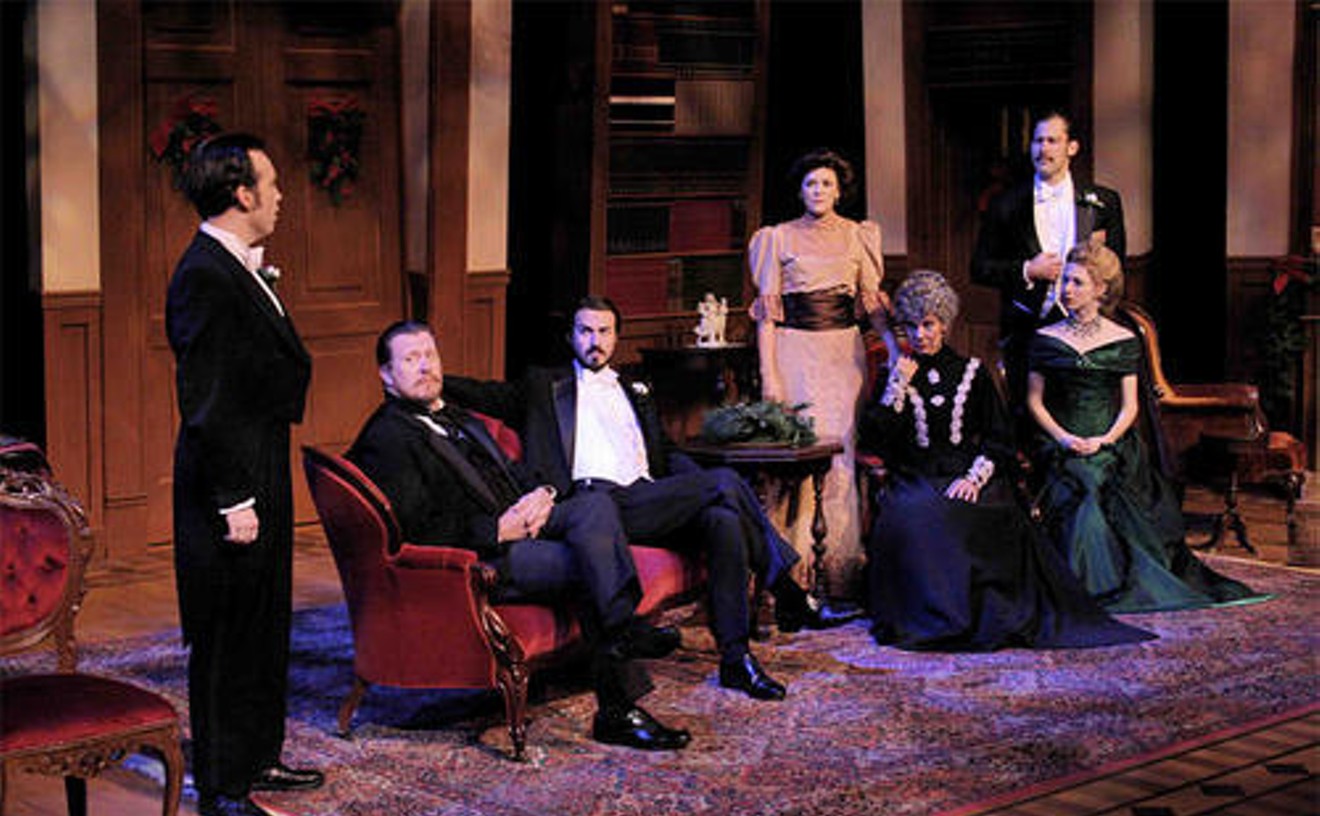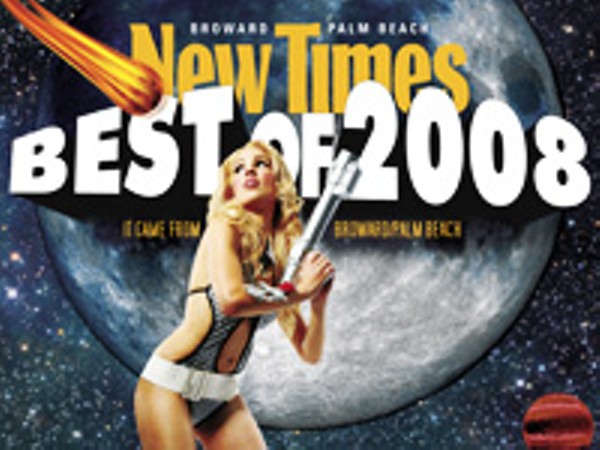It's hard to think of any other local festival more worthy of this honor than Langerado. Sure, this year it took place in the middle of the Everglades, so it technically wasn't in Broward or Palm Beach County, but Langerado is undeniably a homebrewed festival. The organizers live in Broward County and it's thrived here for five of its six years. Organizers of other local festivals are going to have to step it way up to compete with Langerado, which had an insane lineup this year: The Beastie Boys, Matisyahu, R.E.M., Ani DiFranco, the Roots, and Arrested Development all helped the festival veer away from the jam band label it's had since getting started in 2002. The only problem: mid-March in the Everglades can get cold at night. Still, they had over 40 acres for revelers to enjoy, plus lots of delectable food for sale.
Best Musical
Aaron Posner and James Sugg's A Murder, A Mystery, A MarriageFlorida Stage at Plaza Del Mar Shopping Center

Who cares if Mark Twain's long-missing short story really needed a musical adaptation? The more pressing question is this: did music this good actually need to be wrapped around any story at all? No. Though the Twain-inspired yarn was fun and funny, it was mostly just fluff; when you've got a man dressed as an 1800s prairie granny grinding out fabulous barroom piano, you don't need much else. That's what M3 gave us, and more: that campy piano was the backbone of a whole lot of really beautiful music by James Sugg. Buy the CD, listen to the ditty "God's World," and weep. We would have wept ourselves if there hadn't been so much prairie-drag in the room, which tends to dull one's sensitivity a bit.
- 262 S. Ocean Blvd., Lake Worth, 33462 Map
- 561-585-3433
- www.floridastage.org
Best New Play
Juan C. Sanchez's Red TideThe Promethean Theatre at the Mailman Hollywood Theatre Nova Southeastern University

Near as we can tell, South Florida's got only two playwrights who live up to New Times' standards of both talent and weirdness. One is Marco Ramirez, who mostly sticks to Miami, and whose only full-length offering this year was a pulpy play about a werewolf (but look out next year, when he'll unveil a new play about a guitar riff that opens a portal to hell). The other is Juan C. Sanchez, a mild-mannered gentleman who can usually be found manning the ticket counter at New Theatre in Coral Gables. It would be hard to tell from his boyish, bespectacled face that his brain is the demon-haunted pit of nastiness suggested by Red Tide, mounted by Davie's Promethean Theatre last fall. Red Tide was a film noir-ish nightmare featuring two memory-haunted brothers and a woman with mysterious motives. One brother was a loser with serious cognition problems: at any given moment, it was hard to tell whether he was a cuddly teddy bear or a savage killer. The woman was equally hard to figure: sometimes she came off like a vindictive snake, at other times like a soft-hearted lover. The second brother was forced to play straight man, but he was an egocentric, misogynistic mess. The stories behind these listless souls were unveiled in flashbacks that seemed more like time-travel. The whole show was bottomlessly mysterious, thanks to a script from Sanchez that embraced play, imagination, novelty, and any perversity that happened to drift its way.
- 3301 College Ave., Davie, 33314 Map
- 954-262-5354
- www.nova.edu

South Florida should be very proud. In any other year, Thom Paine, The Clean House, 9 Parts of Desire, or The Fourth Wall would have all been shoe-ins for Best Play. Alas, this was a year of staggering theater, and no show was quite so staggering as Doubt, probably the best play John Patrick Shanley ever wrote. Caldwell Theatre gave it the cast it deserved, and people filing out of the theater were heard to wonder aloud not only about the play's real meaning but about the purpose of theater in general. This year's other great plays were moving or scary or funny, but Doubt made you doubt — not just what happened in the show, but how certain you can be of anything. Shanley's script follows an old-school nun as she seeks to discover whether or not her parish priest is molesting a young pupil. At times you believe that he isn't, that he is, that he might be — and, in a few weird moments of cognitive dissonance, you believe all of these things at the same time. If peeling away our easy grasp on fact versus fiction isn't the greatest thing a show can do, we don't know what is.
- 7901 N. Federal Highway, Boca Raton, 33487 Map
- 561-241-7432
- www.caldwelltheatre.com
Best Reggae Sound System
Black Chiney
Few reggae sound systems around the country gig as often as our own Black Chiney. While perched here in South Florida, the five members of Black Chiney work nearly every corner of the globe, from Europe to Asia to the Caribbean and beyond, keeping up a schedule as rich as the topnotch reggae jams they spin at their parties. Not only are they one of the most accomplished and talked about reggae sounds in the country, they also make impossibly good mixtapes combining hip-hop and dancehall, making them an anomaly within their own industry. At the head of this sound system is Supa Dups, the Buddha-like long-time reggae veteran who handles most of the crew's production and booking. He's the chief architect behind a host of popular dancehall riddims like the Dr. Bird, the Drumline, and a slew of other beats that mainstream artists such as Nina Sky, Collie Buddz, Estelle, and others have used recently. That alone brings enough notoriety to the crew. But like Voltron, this sound system has various components and its other selectors — Bobby Chin, Walshy Fire, Willy Chin Remix, and Dinero — are equally nice in the dancehall. What's best though is that with all the cockiness and bravado attached to dancehall music, the members of Black Chiney are typically the lowest-key guys in the room. They up the ante for what reggae selecting is all about.
Best Rock Band
Big Bang Radio
Coming straight out of Palm Beach County, this quintet kicks ass like no other straight-ahead rock group in Florida. They can be loud and fast when they want to, but lead singer Mike Sanchez always remains easy to understand, making their live shows a treat. This is the same group that made it to the finals of Bodog's Battle of the Bands television show last year and canned their former lead singer on national TV. While that drama probably helped draw more attention to the band, it's the group's music that converts new listeners one by one. Their debut album, To Mars From Babylon, has that rare blend of white collar production and blue collar wallop. You can drink to these songs, get laid to these songs, and feel inspired by them. The drums, bass, and guitars are all tight. And you can always dance your troubles away at a Big Bang Radio show.
Best Set Design
Tim BennettThe Clean HouseCaldwell Theatre

The Clean House was a play about the importance of getting filthy, and no play in the last year or two has enjoyed a set that so perfectly captured its theme. Beginning as the oppressively clean domicile of a couple of doctors, by the end the stage is an irreparable mess — or so it would appear; since they had to repeat the process several times a week, the irreparability of the cast's wanton destruction was probably an illusion. At one point, the house gave way to a two-story beach bungalow hiding behind it: as one of the doctors and his paramour partied on the bungalow's balcony, they loosed both symbolic and actual detritus on the ever-filthier home below. Later, the house suffered the further indignity of having an uprooted yew tree dragged through the living room. The place was so sparklingly sterile at the beginning that its slow destruction was physically painful to watch, like seeing somebody get deflowered. But it was also liberating. Which was the point.
- 7901 N. Federal Highway, Boca Raton, 33487 Map
- 561-241-7432
- www.caldwelltheatre.com
Best Solo Exhibition
"Georgia O'Keeffe: Circling Around Abstraction"

Georgia O'Keeffe is one of those artists we think we know oh so well and hence often take for granted. Gigantic close-ups of flowers? Check! Bleached-out cattle skulls? Check! And it was just such assumed familiarity that made the Norton's "Georgia O'Keeffe: Circling Around Abstraction" such a delightful surprise. Working from a deceptively simple common denominator — abstract works making use of more or less circular forms — curator Jonathan Stuhlman (formerly of the Norton) assembled a career overview that let us see O'Keeffe anew. The show, which originated at the Norton and moved on to the museum devoted to the artist in Santa Fe, partook freely from O'Keeffe's many subjects, including those ubiquitous flowers as well as landscapes and still lifes, with some especially inventive takes on the latter among the highlights. The exhibition gave us a well-rounded portrait of a major American artist who was consistently ahead of her time throughout a long, productive career that spanned the better part of a century.
- 1451 S. Olive Ave., West Palm Beach, 33401 Map
- 561-832-5196
- www.norton.org
Best Supporting Actor
Terrell Hardcastle DoubtCaldwell Theatre

As Father Brendan Flynn in John Patrick Shanley's Pulitzer Prize-winning Doubt, Terrell Hardcastle had what looked like the time of his life screwing mercilessly with the heads of his audience. Doubt is a play about, well, "doubt" — specifically, the doubt of a nun considering what to do about a priest whom she suspects is molesting a pupil. She isn't quite sure, of course, and neither are you. There's the rub. But you think you're sure, over and over again: big bad Sister Aloysius comes out, makes her case against the priest, and you're totally sold. You're ready to pull the bastard's eyes out. Then he appears, full of love and light and seeming good sense, and within minutes you can't imagine he's anything but the kind, wise, virtuous man he says he is. Any good actor can make an audience believe in him. Doing this after an audience has already made up its mind not to believe in him — that's not talent, but greatness.
- 7901 N. Federal Highway, Boca Raton, 33487 Map
- 561-241-7432
- www.caldwelltheatre.com
Best Supporting Actress
Pat BowieDoubtCaldwell Theatre

Doubt had the two trickiest supporting roles of the theater season, and in retrospect it's hard to imagine Pat Bowie's part going to anyone else. Bowie played Mrs. Muller, a black mother in the 1960s Bronx, whose young son may or may not have been molested by a parish priest. Bowie's sole scene came when she was summoned to the office of the school's headmistress, the very-stern Sister Aloysius. Aloysius voiced her suspicions, and Mrs. Muller, rather than being shocked or horrified, told the nun to mind her own business. Apparently, Mrs. Muller believed there were worse things than being diddled by a man of the cloth. Aloysius was horrified, and so was anybody who happened to be sitting in the audience. But in the 10 minutes that followed, Mrs. Muller became a genuinely sympathetic character — so convincing was Pat Bowie that you figured plenty of theatergoers must have come around to her side.
- 7901 N. Federal Highway, Boca Raton, 33487 Map
- 561-241-7432
- www.caldwelltheatre.com





